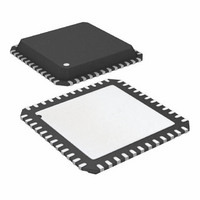AD7631BCPZ Analog Devices Inc, AD7631BCPZ Datasheet - Page 21

AD7631BCPZ
Manufacturer Part Number
AD7631BCPZ
Description
IC,A/D CONVERTER,SINGLE,18-BIT,CMOS,LLCC,48PIN
Manufacturer
Analog Devices Inc
Series
PulSAR®r
Datasheet
1.AD7631BSTZ.pdf
(32 pages)
Specifications of AD7631BCPZ
Number Of Bits
18
Sampling Rate (per Second)
250k
Data Interface
Serial, Parallel
Number Of Converters
1
Power Dissipation (max)
120mW
Voltage Supply Source
Analog and Digital
Operating Temperature
-40°C ~ 85°C
Mounting Type
Surface Mount
Package / Case
48-VFQFN, CSP Exposed Pad
Lead Free Status / RoHS Status
Lead free / RoHS Compliant
• The driver needs to have a THD performance suitable to
The AD8021 meets these requirements and is appropriate for
almost all applications. The
compensation capacitor that should have good linearity as an
NPO ceramic or mica type. Moreover, the use of a noninverting
+1 gain arrangement is recommended and helps to obtain the
best signal-to-noise ratio.
The
and a gain of 1 is present. The
applications where high frequency performance (above 100 kHz)
is not required. In applications with a gain of 1, an 82 pF
compensation capacitor is required. The
when low bias current is needed in low frequency applications.
Because the AD7631 uses a large geometry, high voltage input
switch, the best linearity performance is obtained when using
the amplifier at its maximum full power bandwidth. Gaining
the amplifier to make use of the more dynamic range of the
ADC results in increased linearity errors. For applications
requiring more resolution, the use of an additional amplifier
with gain should precede a unity follower driving the AD7631.
See Table 9 for a list of recommended op amps.
Table 9. Recommended Driver Amplifiers
Amplifier
AD829
AD8021
AD8022
ADA4922-1
AD8610/
AD8620
Single-to-Differential Driver
For single-ended sources, a single-to-differential driver, such
as the ADA4922-1, can be used because the AD7631 needs to
be driven differentially. The 1-pole filter using R = 15 Ω and
C = 2.7 nF provides a corner frequency of 3.9 MHz.
N is the noise factor of the amplifier (1 in buffer
configuration).
e
of the op amps connected to IN+ and IN−, in nV/√Hz.
This approximation can be utilized when the resistances
used around the amplifiers are small. If larger resistances are
used, their noise contributions should also be root-sum
squared.
that of the AD7631. Figure 15 shows the THD vs. frequency
that the driver should exceed.
AD8022
N+
and e
N−
can also be used when a dual version is needed
Typical Application
±15 V supplies, very low noise, low frequency
±12 V supplies, very low noise, high frequency
±12 V supplies, very low noise, high frequency, dual
±12 V supplies, low noise, high frequency,
single-ended-to-differential driver
±13 V supplies, low bias current, low frequency,
single/dual
are the equivalent input voltage noise densities
AD8021
AD829
needs a 10 pF external
is an alternative in
AD8610
is an option
Rev. A | Page 21 of 32
For unipolar 5 V and 10 V input ranges, the internal (or
external) reference source can be used to level shift U2 for
the correct input span. If using an external reference, the values
for R1/R2 can be lowered to reduce resistive Johnson noise
(1.29E − 10 × √R). For the bipolar ±5 V and ±10 V input
ranges, the reference connection is not required because the
common-mode voltage is 0 V. See Table 10 for the different
input ranges for R1/R2.
Table 10.R1/R2 Configuration
Input Range (V)
5
10
±5, ±10
This circuit can also be made discretely, and thus more flexible,
using any of the recommended low noise amplifiers in Table 9.
Again, to preserve the SNR of the converter, the resistors R
R
VOLTAGE REFERENCE INPUT/OUTPUT
The AD7631 allows the choice of either a very low temperature
drift internal voltage reference, an external reference, or an
external buffered reference.
The internal reference of the AD7631 provides excellent
performance and can be used in almost all applications.
However, the linearity performance is guaranteed only with
an external reference.
Internal Reference (REF = 5 V)(PDREF = Low,
PDBUF = Low)
To use the internal reference, the PDREF and PDBUF inputs
must be low. This enables the on-chip band gap reference, buffer,
and TEMP sensor resulting in a 5.00 V reference on the REF pin.
The internal reference is temperature-compensated to 5.000 V
±35 mV. The reference is trimmed to provide a typical drift of
3 ppm/°C. This typical drift characteristic is shown in Figure 19.
ANALOG
G
INPUT
should be kept low.
Figure 31. Single-to-Differential Driver Using the ADA4922-1
IN
ADA4922-1
R1 (Ω)
2.5 k
2.5 k
REF
R
R2
G
U2
R
R2 (Ω)
2.5 k
Open
100
F
100nF
R1
OUT+
OUT–
Common-Mode Voltage (V)
2.5
5
0
2.7nF
2.7nF
15Ω
15Ω
VCC
VEE
AD7631
IN+
IN–
AD7631
10µF
REF
F
and












